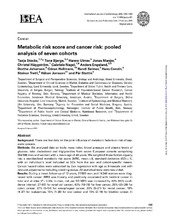| dc.description.abstract | Background: There are few data on the joint influence of metabolic factors on risk of separate cancers. Methods: We analysed data on body mass index, blood pressure and plasma levels of glucose, total cholesterol and triglycerides from seven European cohorts comprising 564 596 men and women with a mean age of 44 years. We weighted those factors equally into a standardized metabolic risk score [MRS, mean = 0, standard deviation (SD) = 1], with an individual’s level indicated as SDs from the sex- and cohort-specific means. Cancer hazard ratios were calculated by Cox regression with age as timescale and with relevant adjustments including smoking status. All statistical tests were two-sided. Results: During a mean follow-up of 12 years, 21 593 men and 14 348 women were diagnosed with cancer. MRS was linearly and positively associated with incident cancer in total and at sites (P < 0.05). In men, risk per SD MRS was increased by 43% (95% confidence interval: 27–61) for renal cell cancer, 43% (16–76) for liver cancer, 29% (20–38) for colon cancer, 27% (5–54) for oesophageal cancer, 20% (9–31) for rectal cancer, 19% (4–37) for leukaemias, 15% (1–30) for oral cancer and 10% (2–19) for bladder cancer. In women, risk increases per SD MRS were 56% (42–70) for endometrial cancer, 53% (29–81) for pancreatic cancer, 40% (16–67) for renal cell cancer, 27% (9–47) for cervical cancer and 17% (3–32) for rectal cancer. Conclusion: This largest study to date on the joint influence of metabolic factors on risk of separate cancers showed increased risks for several cancers, in particular renal cell and liver cancer in men and endometrial and pancreatic cancer in women. | en_US |

